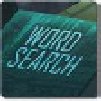Game Development Reference
In-Depth Information
actually released a separate soundtrack for the game, and it has the
ignominious distinction of being considered to be the i rst stand-alone
audio soundtrack in the video game industry.
Nintendo NES
Test your knowledge
of
classic arcade
games
by going over
to the App, and in
the main Classroom
area, click on the Word
Search topic!
With the release of the Famicom (FAMIly COMputer), which in the US
was redesigned and named the NES, Nintendo rescued the console video
game industry after one of its worst crashes, while at the same time
creating a platform for arcade sounds and music that set the standard for
video games for years to come.
The NES offered significant improvements in hardware over earlier
consoles, especially in terms of video, but improvements to audio
were also significant. It featured three synthesized musical voices
(two pulse waves and one triangle wave) plus one noise channel
multi-voice-synthesized waveforms and the ability to play PCM
(pulse-code modulation) audio at 6 bits up to 33KHz (we'll talk more
about what this means later in the course). This enabled composers to
create primitive but reasonably full sounding music, and set the stage
for composers who created those aforementioned unforgettable
themes.
The NES from Nintendo is largely credited
with rescuing the industry from the video
crash of 1982, and set the standard for
game consoles to come.
Credit:
Evan Amos.
NES played the
Donkey Kong
titles plus a new hit,
Super Mario Bros
, an
immensely popular game allegedly responsible for resurrecting the
video-game industry. This console is also considered the i rst mature
system; because the quality of its hardware approached the level in
existing arcade of erings, the NES convinced a signii cant percentage of
arcade gamers to stay home to play games, thus presaging the eventual
downfall of the arcade industry.
1990s
As we move into the 1990s, cartridges become more sophisticated and
hold a lot more data. There's also a new player in the game—CD-ROM.
The introduction of this medium was a real game changer in the world of
game audio—it opened up the doors to polyphonic MIDI, higher bit rates,
and higher sample rates. Cartridges did not hold all that much information
(a few megabytes for everything, actually) and that had to be shared
among all the media. (The available memory for sounds for a cartridge
game could be as low as 64KB!) Although it might seem like there would
now be more than enough room, we will see in the next level what
challenges composers and sound designers faced with the new medium.





































